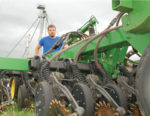Advertise Follow Us
Articles Tagged with ''Wheat''
30-year no-tilling veteran Tom Clark is reaping the benefits of tiling improvements, cover crops and calculated planting on his 1,200 acres.
Read More
What I've Learned from No-Tilling
No-Tilled To Save Time, But Quickly Saw Soil Benefits
Western North Dakota farmer integrates cattle, dryland corn and multiple cover-crop species to build a productive no-till system.
Read More
No-Till, Profitability Going Hand in Hand
Josh Lloyd, the ASA’s 2010 National Conservation Legacy Award winner, uses yield mapping, cover crops and more to make no-till work.
Read More








